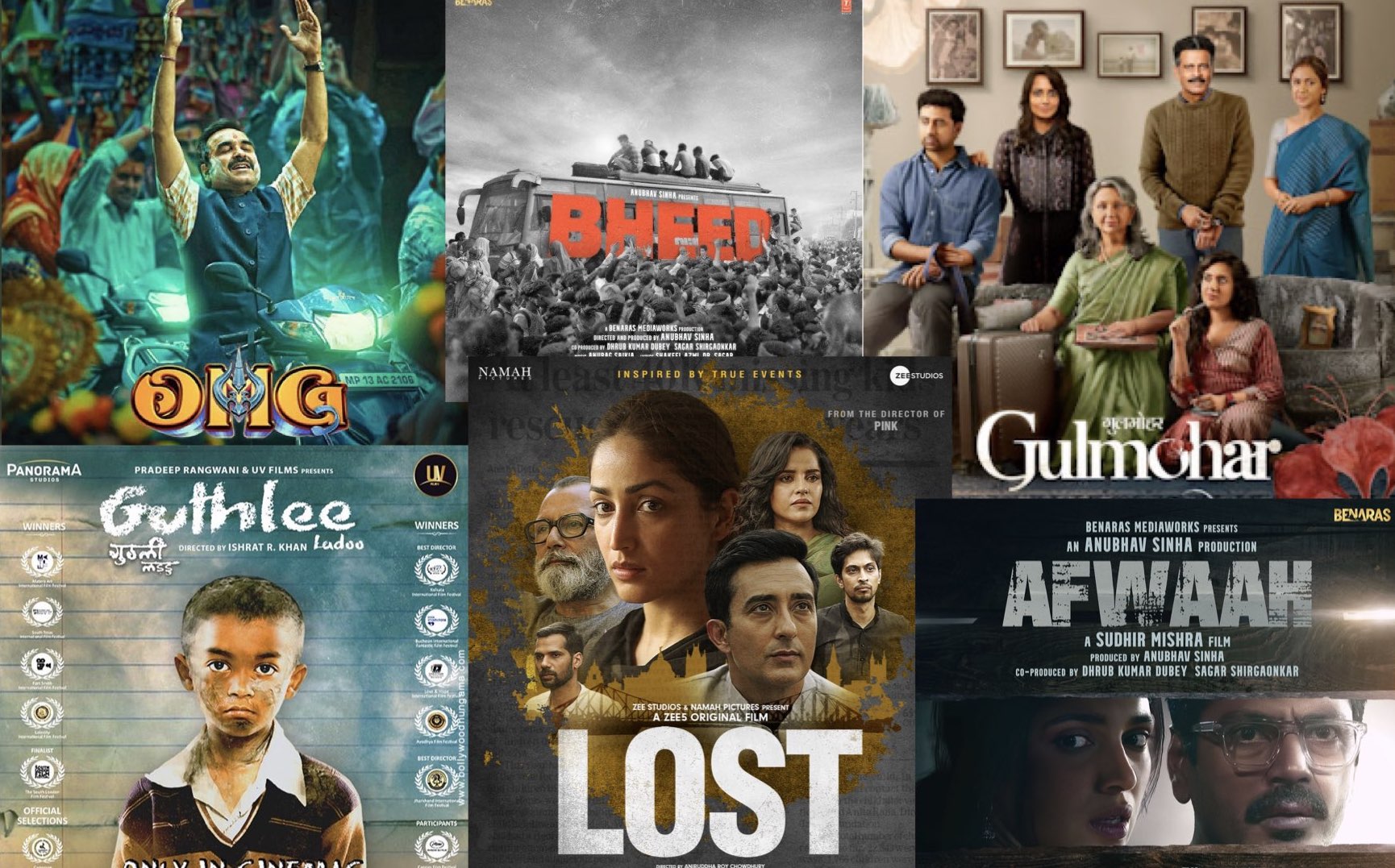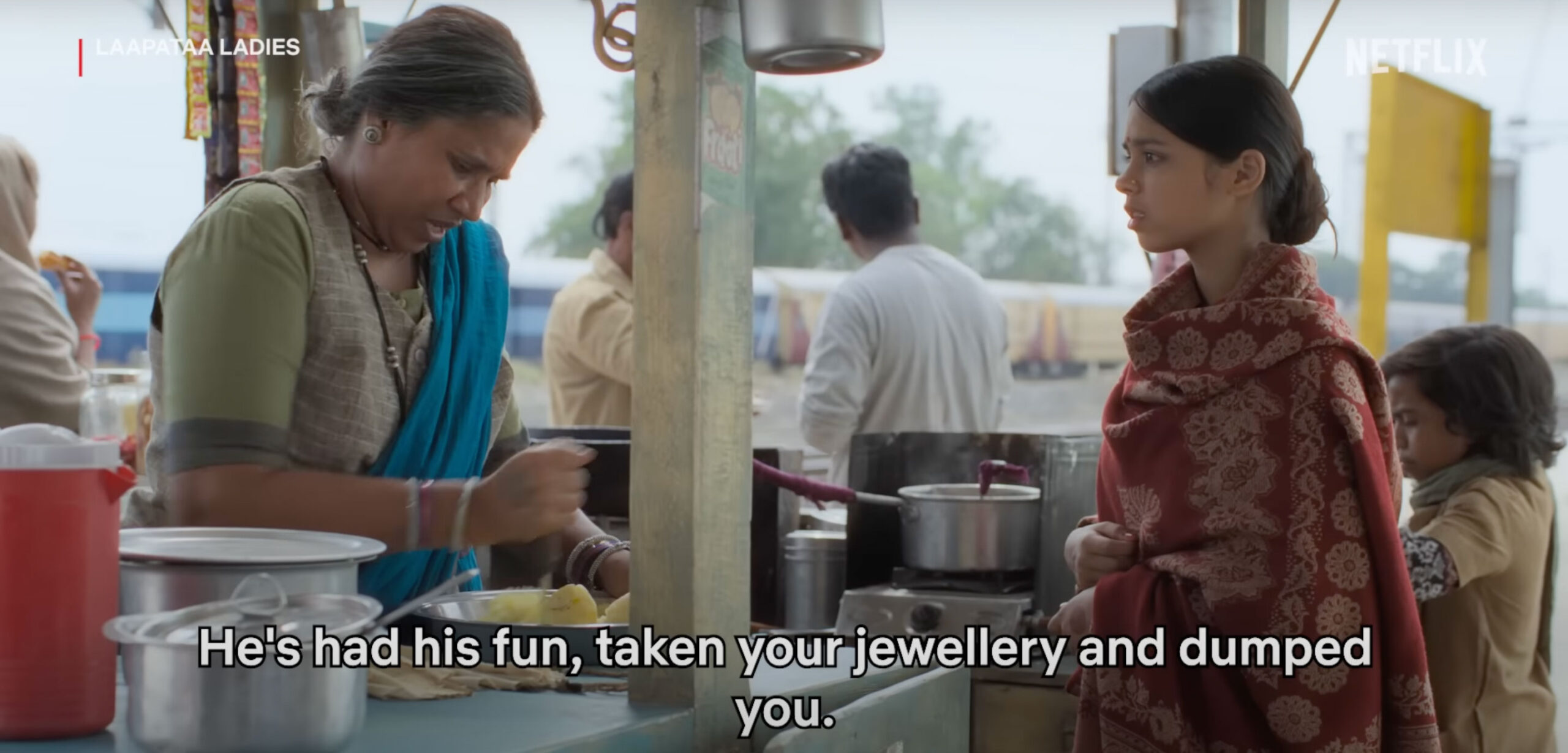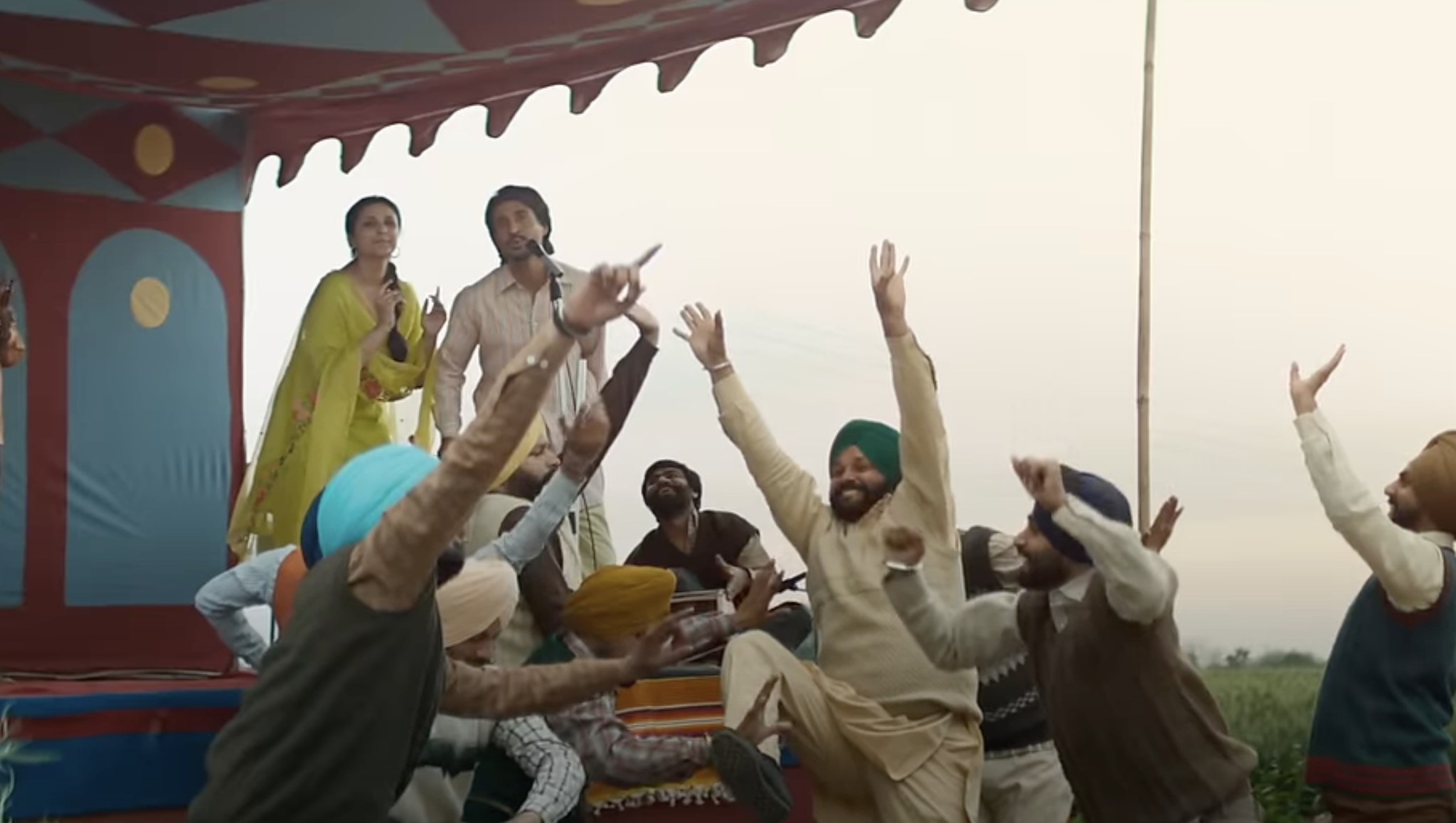In the cinematic landscape of 2023, filmmakers have presented an array of narratives that delve into the complexities of social and familial dynamics. Patriotism, too, is a theme in some of these films, in which soldiers and myths play their part. Then there are biopics, and finally the anti-caste films that bring out the discomfiting truths of our society.
This analysis of the films released in 2023 may inadvertently overlook certain films, the selection being biased towards those that have garnered widespread attention within the Hindi film industry. Additionally, there may be films that have eluded broader recognition, but are nonetheless significant within the context of this discourse.
Part I: Social and family drama
In Anubhav Sinha’s film Bheed, the protagonist’s agency, as a duty-bound and aspirational police inspector, is seemingly contingent upon the Brahmin characters, Balram Trivedi and his girlfriend Renu Sharma. This narrative dynamic suggests a reliance on the “Savarna gaze” in shaping the Dalit protagonist’s identity and trajectory. While Bheed aims to depict the nuances of the COVID-19 lockdown and its impact, the portrayal of Dalit-Brahmin couple love is filtered through this Savarna lens. Sinha’s attempt to position the Dalit protagonist as a saviour of the Brahmin character, following criticism for his use of an uninformed “upper-caste” protagonist as a saviour in Article 15, appears problematic. The Dalit protagonist’s traumatic past, revealed even during intimate scenes with his “upper-caste” girlfriend, reinforces the lingering effects of caste-based discrimination. His disbelief in being touched by a non-Dalit further emphasizes the ingrained nature of caste hierarchies. Additionally, his heroic actions seem to require the validation of Renu Sharma and Balram Trivedi, reinforcing the protagonist’s dependence on the “Savarna gaze” for self-definition. This approach perpetuates the power dynamics inherent in the caste system, limiting the potential for a more nuanced and empowering portrayal of Dalit-Brahmin relationships.
OMG 2 (directed by Amit Rai) revolves around the significance of sex education, exploring the intricacies of religion and science. It incorporates the interference of a divine messenger, courtroom debates, and culminates in the victory of one faction over the other. This win-loss dynamic reflects the dichotomy within Hinduism, in which only “upper-caste” characters lose and win. It is yet another instalment in a series of films made from a “Savarna gaze” that promote Gandhi’s ideas for fighting caste – “religious reformism”, “change of heart” and casteism being “internal affairs” – where the “presence” of the Dalitbahujan is once again absent. A Dalit could find disturbing the graffiti of Dr Ambedkar alongside images of the Hindu deity Lord Shiva and a Shivalinga in a scene. This detail, along with the plot, betray the filmmaker’s desire to establish the victory of Gandhi and the Hindu religion’s “morality” over the social crusader who spoke of dynamiting Hindu scriptures for the establishment of social justice and who renounced the religion.
Lost (directed by Aniruddha Roy Chowdhury) is about Vidhi, a young female crime reporter, investigating the disappearance of a young Dalit theatre activist named Ishan. This multifaceted story serves as a commentary on the disintegration of societal values and ethical principles. The central plot revolves around Vidhi, her “upper-caste” family background, her romantic entanglement, her progressive ideals, her innate independence, her unwavering dedication to her profession, and the unwavering support she receives from her grandfather. Vidhi’s endeavours to adopt a more feminist stance and to empathize with the plight of the Dalit community, particularly Ishan’s family, are presented in an excessively dramatic manner. Ishan and his family act as a mere vehicle to highlight Vidhi’s unwavering commitment to her work, her family ties and her romantic relationship.
The portrayal of Dalit characters as sidekicks in films by “upper-caste” directors undermines their agency and diminishes their potential to be portrayed as Dalit activists or artists. In films such as Article 15 and Lost, Dalit characters are killed or involved in Naxalite insurgency, blurring their identities, and allowing the philanthropic image of “upper-caste” characters to emerge. This problematic representation reinforces the power structure that marginalizes Dalit voices.
Zwigato (directed by Nandita Das) delves into the life of an honest food-delivery person struggling to make ends meet for his family, consisting of his wife, two children, and ailing mother. The film intricately weaves together the challenges faced by the protagonist in providing for his family, particularly the financial burden of his children’s education in a prestigious English medium school. This paradox raises questions about the subjectivity of the film, as it portrays the class divide and economic hardships faced by the protagonist while highlighting the contrasting realities of marginalized communities, such as a child waste-picker and his father.
Nandita Das showcases the disparity in opportunities and privileges with only one frame and does not question why the scavenging community’s children do not have access to education and proper clothing. By juxtaposing the jarring image of a child with unkempt hair in tattered clothing with the well-dressed, school-going children of the protagonist, the film perpetuates harmful stereotypes against marginalised communities. It does so by focusing solely on economic class while overlooking the complexities of caste and its enduring impact on these communities. Using the protagonist’s life, the film explores systemic problems like unemployment. Furthermore, Zwigato incorporates elements of social activism, such as protests against the government. The resistance is expressed through songs and placards bearing Faiz’s poetry and the banner of the Mazdoor Kisan Shakti Sangathan (MKSS), a prominent people’s movement in Rajasthan led by Aruna Roy. In this way, the film serves as a commentary on societal issues, shedding light on the struggles of the working class, and the need for collective resistance against systemic injustices. To any foreigner watching Zwigato, it could feel like the class distinctions overwhelm caste dynamics in India. The protagonist and his wife are both caste Hindus and are discriminated against by affluent caste Hindus. The director deliberately obscures the caste divides, utilising thematic elements that veer away from explicit caste-related issues. This deliberate choice suggests a leaning towards the Left ideology in addressing socio-economic disparities in India.
Guthlee Ladoo (directed by Ishrat R. Khan) has a poignant narrative centred on Guthlee, a Dalit child with an unwavering aspiration to pursue education. Inspired by an encounter with a Dalit government officer, Guthlee’s father strives to gather funds for Guthlee’s admission to Saraswati Vidya Mandir, an RSS-affiliated school in their village. However, deep-rooted caste discrimination turns out to be a bigger obstruction that needs to be overcome. The derogatory term “Bhangi”, commonly used for the Dalit community engaged in scavenging, is repeatedly employed by “upper-caste” children to humiliate Guthlee – just as is often the case in real life.
Hari Shankar Vajpayee, a Brahmin teacher, introduces a metaphorical interpretation of the term “Harijan”, which translates to “children of Hari (god)”, reinforcing the notion of Dalits being subservient to Brahmins (indicated by his name and caste). The film delves into the societal dynamics and decodes Gandhi’s message behind assigning the “Harijan” surname to Dalits.
Hari Shankar tells Guthlee’s father Mangru, “God doesn’t discriminate; it’s people who practise discrimination”. Inspired by his apparently Gandhian principles, Hari Shankar instils consciousness in the Dalit community, starting with Mangru, about their rights. Having imbibed Hari Shankar’s values, Mangru passionately conveys to society that the Constitution grants equality to all, irrespective of caste. He says that every individual, be they from an “upper” or “lower caste”, holds an equal and valuable vote. One person asks how the votes of the Dalit community could be considered equal to “upper-caste” votes when the former vote in exchange for meagre daily wages and alcohol. This again brings to the fore the stereotype that Dalits are uneducated, poor, hungry and helpless and they sell their votes. The camera then turns to the inner turmoil of Hari Shankar, an “upper-caste” character, rather than deeply investigating the assertion of the Dalit community, which ultimately finds a way to include Guthlee in the education system. This twist echoes a recurring theme in Savarna films – the portrayal of the “humanitarian” attitude of the “upper-caste”, them being saviours and change-makers.
The tragic demise of Ladoo, Guthlee’s friend and fellow Dalit child, while cleaning a gutter serves as a stark symbol of the perilous conditions many Dalit children face and the systemic denial of their right to education. The title, Guthlee Ladoo, itself carries symbolic significance, alluding to the mango pit that is discarded after eating the flesh. The Savarna filmmakers’ use of the name, suggesting a lack of self-worth or significance, extends the conceptual lineage established in Ashutosh Gowarikar’s 2001 film Lagaan. In Lagaan, the name Kachra, meaning “garbage”, embodies a sense of disposability and lack of value. This shared thematic choice, where names consistently carry negative connotations, shows the potential for names to be instruments of oppression and devaluation within narratives. The narrative further explores the early awareness of caste among Dalit children, vividly portrayed through Guthlee’s mother explaining to her son the bearing of their caste on their educational opportunities. The film encourages reflection on caste identity, echoing the question posed by SP Ayan Ranjan in Article 15: “Who am I? What is my caste?”
The visual representation of Dalit characters, particularly the child protagonists Guthlee and Ladoo, consists of tattered clothing, highlighting their socio-economic struggles. The blackening of their faces aims to supposedly “authentically” represent the appearance of Dalits, a nuanced aspect explored in Rajesh Rajamani’s film, The Discreet Charm of the Savarna.
The film’s theme is “Equal Right to Education for All”. However, the portrayal of Dalits in torn and dirty clothes resembling Gandhi’s “Harijan” who hope for improvement through reconciliation with the privileged castes suggests otherwise. If a Dalit character in a good position is shown, it is quickly overshadowed. For example, the Dalit government officer throws a few words of wisdom at Mangru, shows little sympathy, and is never to be seen again.
The name “Harijan”, assigned by Gandhi for Dalits but rejected by Dr Ambedkar because he saw the name perpetuating the existing situation, does not bring awareness among Dalits, exposing the limitations of the Gandhian ideology when it comes to Dalit empowerment. Instead of inspiring us the Dalit audience, it resurrects our trauma and takes us back to the past.
Kathal (directed by Yashowardhan Mishra), a satirical comedy exploring the pervasiveness of red tape, simultaneously delves into the intricate social and economic fabric of Indian society. At the heart of the narrative stands Mahima Basor, played by Sanya Malhotra, an intrepid police inspector determined to navigate the labyrinthine system. While the film’s attempt to showcase a Dalit woman protagonist is commendable, its shortcomings lie in its perpetuation of certain stereotypes about the Dalit community and its handling of the contentious issue of “merit” versus “reservation”.
Afwaah (meaning ‘rumour’, directed by Sudhir Mishra) serves as a timely and cautionary tale in the age of rampant misinformation and social media’s echo chambers. The film explores the insidious power of rumours and the chaos they can unleash in an already divided society. The film portrays the influential role of Rajputs in the political landscape of Rajasthan, depicting the tactics employed by them to remain in power. It sheds light on manipulative strategies, including the propagation of Hindu-Muslim communal tensions and the amplification of controversial issues such as love jihad, to orchestrate disturbances. The film uses the fictional, colonial-sounding name “Western Province” instead of Rajasthan, subtly implying the continuity of princely states ruled by Rajput monarchs even after Independence, now sustained under democratic rule. It seems like Sudhir Mishra draws inspiration from Anurag Kashyap’s Gulaal, which explores the theme of Rajputs reclaiming lost power after independence and their endeavour to re-establish the Rajputana principality. In addition to the issues that these films highlight, they also serve as a monolithic narrative by subsuming Rajasthan in the stories of Rajputs, disregarding the stories and traditions from and differences among the rest of the population.
Gulmohar (directed by Rahul V. Chittella), the titular flame tree, serves as a poignant symbol of the Batra family’s evolving dynamics as they prepare to leave their ancestral home, echoing the inexorable passage of time and the inevitable changes that life brings. The film’s portrayal of the Batra family’s struggles and triumphs may resonate with some viewers, but it also excludes the experiences of “the other” in India, such as Dalits and other lower-caste Hindus and Muslims and other minorities. These people are only servants to the Batra family. In the film’s narrative, it is revealed later that Arun, the protagonist, is the adopted son of the Batra family. Even after learning of his adoption, Arun does not reveal his true identity to his biological father, the impoverished owner of a roadside eatery. In this way, the film reinforces the notion of destiny rather than exploring the complex interplay of social structures, policies, and individual efforts in shaping one’s life trajectory. The film’s focus on Arun’s success, regardless of his origin – which is only disclosed later in the film – presents a narrow and incomplete understanding of social mobility. While the original social standing of the protagonist highlights the progressive and liberal tendencies within the “upper-caste”, the entire film otherwise revolves around the challenges arising from the familial milieu of the Batra family and the act of departing from their home, “Gulmohar”, intertwined with nostalgic memories. The thematic selection of this film resonates with the 1956 film Sujata, affirming the idea that welcoming individuals from the marginalized strata into the Savarna environment involves “adopting” them and subsequently shaping them as Savarnas in keeping with their norms.
The film Animal (directed by Sandeep Reddy Vanga) has been criticised for its portrayal and promotion of hypermasculinity and objectification of women. Noteworthy was the film’s subtle promotion of Modi’s policies, such as “Atmanirbhar Bharat” (self-reliant India) and “Made in India”. Amid the violence and romance, the filmmaker subtly weaves in elements showcasing loyalty to Modi’s governance. The filmmaker adds another layer to the ideological perspective by portraying the villain as Muslim, thereby contributing to the narrative of establishing a Hindu Rashtra that has taken root under the present political regime. Additionally, the film incorporates the appropriation of a Kabir couplet to justify the wrongful actions of the protagonist. The film also addresses the issue of inter-caste marriage. The protagonist, Ranvijay, marries Geetanjali, who is from another upper caste. While this is not a ground-breaking or radical action, the film’s focus on this issue suggests that the filmmaker is trying to make a statement about caste relations in India. If this is an attempt to project progressiveness, it comes out as rather hollow. Bawaal (directed by Nitesh Tiwari) is about an image-obsessed history teacher Ajay who embarks on a journey to Europe with his epileptic wife Nisha to escape his crumbling marriage and a student-slapping scandal. As they are confronted with historical horrors (the Holocaust) and Nisha’s silenced voice emerges, their relationship transforms. By focusing solely on Ajay and Nisha, both belonging to “upper castes”, the film becomes trapped within a privileged bubble. It fails to offer a nuanced understanding of how caste operates across societal levels, particularly towards those at the bottom of the hierarchy. The experiences of Dalit-Bahujan communities, marked by systemic discrimination, economic marginalisation, and social exclusion, are completely absent from the narrative. While the film uses World War II as a reference point for broader themes of oppression, it overlooks the historical erasure of caste-based atrocities back home.
The Great Indian Family (directed by Vijay Krishna Acharya) follows Ved Vyas Tripathi, a devout Hindu singer, whose world crumbles when he discovers he is actually Muslim by birth. Navigating this identity crisis, family tensions, and a blossoming romance with a fellow singer, Ved grapples with reconciling his faith, heritage and newfound truth in a society wrestling with its own complexities. Despite good performances and a relevant theme, the film received mixed reviews for its uneven narrative and messaging. Through this kind of plot line whose theme is inclusivity, the spotlight is again on the progressiveness and liberality of the Savarna world. Similarly, The Archies (directed by Zoya Akhtar), is a nostalgic trip to 1960s India. It subtly weaves in aspects of Anglo-Indian history and identity. We see the characters grapple with questions of belonging, straddling two cultures yet feeling they don’t fully fit in either. It is a proper utopian world of the rich “upper-caste”, based on the American comic book, gaining attraction among the middle-class millennials and Gen Z of the metro cities who appreciate the retro vibes and relatable themes. It also serves as a launchpad for star kids, including Suhana Khan (daughter of Shah Rukh Khan), Khushi Kapoor (daughter of Sridevi) and Agastya Nanda (grandson of Amitabh Bachchan).
The discussion highlights a crucial issue: films by “upper-caste” filmmakers often centre social and economic problems without explicitly tackling them head on. This filmmaking approach can leave the audience confused and contributes to the construction of an illusory paradigm, aligning with the Gandhian concept of social reformism. Within this thematic domain, a subset of films explores the dynamics of “upper-caste” families, delving into their internal conflicts, cultural nuances and social discipline, thereby underscoring the significance of tradition. This cinematic exploration extends beyond mere narrative representation, encapsulating the perpetuation of cultural values and the reinforcement of familial structures within the broader social context.
(Note: I have consistently employed the term ‘Savarna gaze’ to delineate the perspective of “upper-caste” filmmakers in defining and depicting the positionality of the Dalitbahujan character within the cinematic realm. Savarna gaze is a term used to describe the way upper-caste Hindus (Savarnas) view and represent non-upper-caste individuals (Dalits, Adivasis and Other Backward Castes). It is a gaze that is often characterized by pity, condescension, exoticization and/or appropriation.)
Forward Press also publishes books on Bahujan issues. Forward Press Books sheds light on the widespread problems as well as the finer aspects of Bahujan (Dalit, OBC, Adivasi, Nomadic, Pasmanda) society, culture, literature and politics. Contact us for a list of FP Books’ titles and to order. Mobile: +917827427311, Email: info@forwardmagazine.in)






